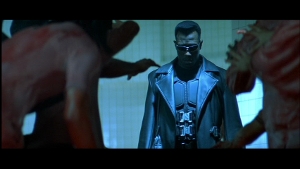
This is a unique specimen, a transitional fossil. It combines the disrespect for an established comic book character’s cannon that defined the Golden Age of the American Superhero Film (which unarguably began with Richard Donner’s Superman) with the complete seriousness and penchant for eye-gouging special effects that went onto define the Silver Age, which would not out-and-out begin until two years after Blade fell off everyone’s radar screens. Everyone but we geeks, that is.
Fact is, we recognized a good thing when we saw one (unless we avoided this flick out of misplaced anti-vampire prejudice). And while it’s not the head-stomping, face-melting, game-changer we hoped it would be, Blade certainly proved something serious creative types (by which I mean, science fiction writers) had known for decades: treat your concept seriously the audience will follow, no matter how fantastically weird your concept might be. Then, as long as you can avoid curb-stomping your audience’s willing suspension of disbelief, it doesn’t matter how well known and beloved your main character might be…though hiring a well-known, beloved actor to play him never hurt anybody.
Blade, the vampire hunter, was neither well-known nor particularly beloved prior to this film. A vampire hunting antihero created in the 70s, which fans know as comic book’s Bronze Age and non-fans know as “the Dark Times,” Blade had what I’d laughingly call his earliest success as a supporting character in Marvel Comic’s House Tomb of Dracula (thank you for nitpicking, David). He’d go on to guest star in many an A-list hero’s book, usually taking the thankless role a strawman Marvel’s more morally nuanced heroes could beat up whenever Blade’s anti-vampire prejudice clashed with their definitions of “the right.”
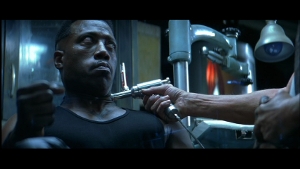
While he was cool and all, Blade never had the kind of following a certain shorter, whiter, much-girlier Vampire Slayer earned by the mid-to-late 90s. (Round about the time production began on this film now that I think about it…hmmm…) This turned out to be a boon for both character and film, since audience expectations never rose higher than the Earth’s outer core, leaving writer David Goyer, director Stephen Norrington, and star Wesley Snipes free to go their own way…and succeed.
That’s what’s so odd about Blade: it’s one of those rare cases where changes made to the titular character while adapting him to another medium actually improved things. Here, Blade sheds the last vestige of his supporting character origins and becomes the apotheosis of badass vampire slayers.
As we see in the pre-credit prologue (which takes home a Gold Medal for a four hundred yard expository dash by establishing Blade’s origin in under two minutes with almost no words), Blade’s mother suffered a vampire attack while carrying him to term. Saved via c-section, Blade grows to manhood walking in both worlds without every really belonging to either. He’s got the super strength and healing factors that make the nightbreed what they are plus blanket immunity from all the glaring weaknesses that plague vampirekind. He can walk in sunlight, eat garlic bread, and fondle silver all damn day if he wants to…all he has to do is spend the rest of his life fighting against the innate bloodlust that’s an intractable part of his superpowered heritage. Maybe, someday…sooner than later, probably…the Need to Feed will force him to become what he wars against.
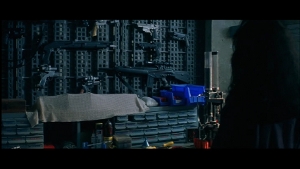
Until then, he’s got Whistler (Kris Kristofferson), his mentor and Alfred in residence. Together with their warehouses full of custom made anti-vampire weapons the two fight a lonely war against the undead, unappreciated and unnoticed by a broader society that’s either accepted vampires completely (if surreptitiously), or operates under the comfortable delusion that they’re still a myth.
And the vampires of this universe are all kinds of cool with that. The assembled heads of the “vampire Nation” speak of a “treaty” signed with “the humans” older than most nation states. Vampires get to do what they want so long as they keep it on the down-low and avoid gathering in large, publicity-drawing numbers. Unfortunately, the upstart vampire Decon Frost (Brad Dorff) is getting a bit sick of hiding in plain sight. “We should be ruling the humans,” he tells the council of pure blood vampires who rule the “nation.” “Christ, these people are our food, not our allies.” And Frost has a plan to realign the world’s power structures complete with a prophecy he intends to fulfill, the resurrection of a vampire god, and (not so surprisingly) a lot of physical and emotional pain for the number one thorn in the Nation’s side – the “Daywalker,” Blade.
Structurally, Blade owes a lot to the American Action films that immediately followed and proceeded it in theaters. It’s exactly two hours long (including credits) and it moves like Wally West after an intravenous caffeine injection. There’s no fat on this film; every element – even the ones I’m about to wipe my ass with – feels essential to the movie’s overall effect.
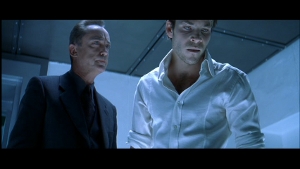
David Goyer’s script is a streamlined exposition machine, creating an illusion of depth that makes Blade feel like a peak into a coherent world. The socio-political-cultural forces that give the world its unique shape fundamentally alter, traumatize, and damage every character we see and no one – not even our Villain, Deacon Frost – is completely immune to that.
In fact, Frost is arguably more interesting than Blade – and not just because of Brad Dorff’s underrated acting skills…or the fact that he has more to do than look cool in a tailor-made trench coat. Born a human, Frost was “turned” at some indeterminate point in the past, making him a second class citizen of the Vampire Nation in the eyes of its rulers, who are to a man “pure bloods” – vampires created (one assumes) through good ol’ fashioned sexual Olympics.
There’s a wonderful scene early on between Frost and the pure blood Gitano (played wonderfully by B-movie veteran Udo Kier). A symbol of every tradition that Frost holds in contempt, Gitano literally slaps Frost down for his lack of respect for the way things are done. Frost laughs this off with a “What are you gonna do, huh?” and a touch on the cheek that suggests a level of familiarity I’m sure Gitano would just as soon no one know about…or even think about. Gitano steps back and shuts Frost down with the ultimate insult Old Money assholes deploy when they want to cut the nouveau riche down to size: “You bore me.”

My mother insists this scene is meant to establish the two as ex-lovers, which I certainly won’t dispute. That intimation adds dimension to two characters who, without this scene, would just be two more one-note villains in a B-grade action movie. Blade escapes this, and this scene is a diagram of that escape hatch. Here we see a distillation of every socio-political tension inherent to the Vampire Nation: a moribund aristocracy that keeps its ambitious bourgeoisie in check through iron bands of “this is how we’ve always done things!” Enter a hot-headed, charismatic revolutionary with a prophecy on his shoulder and enough of a silver tongue to gather his own gang of toughs.
Unfortunately, that prophecy highlights Blade‘s major flaw. Its vampires attempt to straddle the line between supernatural horror and technobabely-science fiction. By the climactic battle (in a location Frost calls “the Temple of Eternal Night”) the film looses its balance and catches that line in the crotch. But since it’s a movie, I’m the one who’s wincing.
How could a culture as stepped in tradition as these vampires forget its ancient gods? Shouldn’t the pure bloods revere La Magra the Blood God as much, if not more than, Frost (who’s surely a recent convert to fundamentalist La Magraism)? After all, unlike most human divinities, La Magra is demonstrably real. So’s Blade, and the prophecy calls him by name…as do several vampires. So legends of the Daywalker must’ve survived into more-modern vampire languages. The rest of Blood God’s prophecy is so old Frost needs the power of product placement (an Apple laptop, of course) to translate it. But later Whistler reads a fragment of the prophecy off of a piece of parchment Blade grabbed out of the vampire archives. How “dead” is your language when a chain smoking, Jack swilling, folk singing, self-educated human can read it?
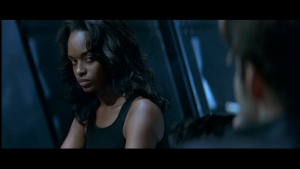
The answer, of course, is “as dead as the script needs it to be.” Let this be warning to filmmakers everywhere: tighten your film’s mythology and its plot holes will become that much wider. Really, all this prophecy business serves to do is set Blade up to fight a giant monster in the third act…a giant monster cut from the film after test screenings revealed the Great Unwashed preferred to watch Wesley Snipes beat the shit out of Brad Dorff…something I won’t dispute, either.
The prophecy also exists because, in the words of another famous vampire Uncle Tom (named Angel) “there’s always a prophecy.” If feels obligatory and tacked on because it really is. I find the prospect of a civil war in the Vampire Nation apocalyptic enough, thanks…and I’m not a semi-professional Slayer.
It also gives Frost an excuse to give Blade the standard “we’re not so different, you and I,” villain monologue. Irony being there’s a fine line between them anyway, what with Blade’s quest to commit vampire genocide. Hyper aware of this, Blade has the prefect excuse to be a brooding, taciturn antihero. Snipes does himself a good turn in this, particularly shinning in his scenes with Kristofferson and N’Bushe Wright, who plays a hematologist accidentally bitten by a vampire Blade didn’t kill fast enough.
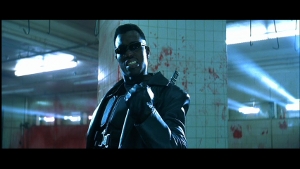
I don’t mean to suggest Wright’s character is superfluous by not mentioning her until now. Really, she’s the audience identification character. We get acquainted with Blade’s and Whistler’s world through her eyes and though her character may be a boring blood Scientist, Wright injects a pragmatic world-weariness into her performance that keeps Dr. Karen from becoming a damsel in distress. Like any good scientist, she accepts the underworld once too much evidence accrues for her to do otherwise. Once that’s over with she devotes herself to finding a cure for vampirism…or, at the very least, an inoculation. Maybe some gene therapy for those already bitten…and a way to make Blade’s bloodlust go bye-bye without destroying his superpowers.
(Of course, he could always steal blood off the seemingly-infinite number of vampire minions currying it across the world during the daylight hours…not like it isn’t already stolen…or like he doesn’t already rob vampire minions to fund his own operation…failing that, there’s always pig’s blood, which is damn close to human…I’ve heard…)
I especially love that, even though Dr. Karen is captured by the villain in a transparent attempt to lure the hero into a third act trap, she winds up saving his ass in the end after Frost’s anti-human prejudice leads him to dismiss her out of hand. And through it all – decapitations, gunplay and swordswinging – there’s not one hint of a romantic subplot between Dr. Karen and Blade. Thank you, movie. For this alone, I prostrate myself at your feet.

Even if I didn’t have that, I’d still have to prostrate myself in front of this film’s cinematography and direction. Like Blade himself, the whole thing is stylized just enough, avoiding the post-Matrix trap of being garish to the point of distraction (here’s looking at you, Paul W.S. Anderson). Jeff Ward, who by this point was working on his fifteenth year in stunt work, designed some excellent fight scenes, and I’m not surprised to find he and Snipes first met on Demolition Man…a feature-length fight scene that saw Snipes face off against a piece of plywood with Sly Stallone’s face unconvincingly stenciled onto it. Here, as there, the action is dynamic without overwhelming the rest of the plot or compromising the story (vampires can’t very well keep themselves secret if they’re kung-fu fighting in the street). It feels like a natural extension of the film rather than the film being an excuse for fighting.
A good superhero film from a time when producers seemed incapable of making them, Blade defied my expectations and stoked up my hopes. Its overall plot falls apart if you think too long about it, but the film as a whole is a rousing success. Believable characters played by good actors who, well directed, Blade makes a lie of the whole “sophomore slump” theory. Director Stephen Norrington’s previous film was a low-budget Alien rip-off called Death Machine. If anything, Blade is his sophomore success. As successful as Superman or Batman? Not really. But on its own merits, Blade succeeds.
![]()
![]()
![]()
![]()

Because I’m a terrible nitpicker and because I own all but the first three issues – Blade first appeared in Tomb of Dracula.
I haven’t looked at the comics since I boxed them about 15 years ago. I remember them as pretty awesome and I’d hate to discover otherwise.
There’s one plot point from this film that I WISH had been carried over wholesale to the sequel (and I would be making this comment there, if you had reviewed it).
Oh, and SPOILER ALERT for those who haven’t seen Blade or Blade 2 yet.
The scene where Gitano is taken outside by Frost and explodes in the first rays of sunrise, you remember that, right? Because it’s a damned cool scene with a big explosion at the end. Now, Nyssa, from the end of Blade 2, was also a very old pure blood. And taken outside into the first rays of sunrise to perish.
How much more hilarious if that scene played out the exact same way it does now (sappy music, tender looks), only at the very end she blows like a half-stick of dynamite and sends Blade crashing through the front windows of the building behind him. I think I would have killed myself laughing.
These days the CGI stunt doubles, and the memory of how easily an uncritically my peer group and I accepted them back in 2002, are what double me over with laughter. But I’ll be revisiting Blade 2 in the not too distant future, and hopefully close out the trilogy sometime before the world ends. And we’ll be talking about Nyssa. Oh yes. And the rest of that strange, schizophrenic little film.
Do we have to go over Blade Trinity? I mean, do we really, really have to? If you want to cover everything that went wrong with the third Blade film, you’d better do some typing exercises first, and have a pot of coffee handy, because it’s gonna be a long review.
Having lived through (and reviewed) Catwoman, I almost want to say, “There’s nothing Blade: Trinity could possibly throw at me.” But that would, of course, be an absurd exercise in tempting fate. Anyone who avoided theaters in 2004 (including my younger self) was one hundred percent correct in doing so.
I love Deacon Frost. He is so sexy!
You are not alone.